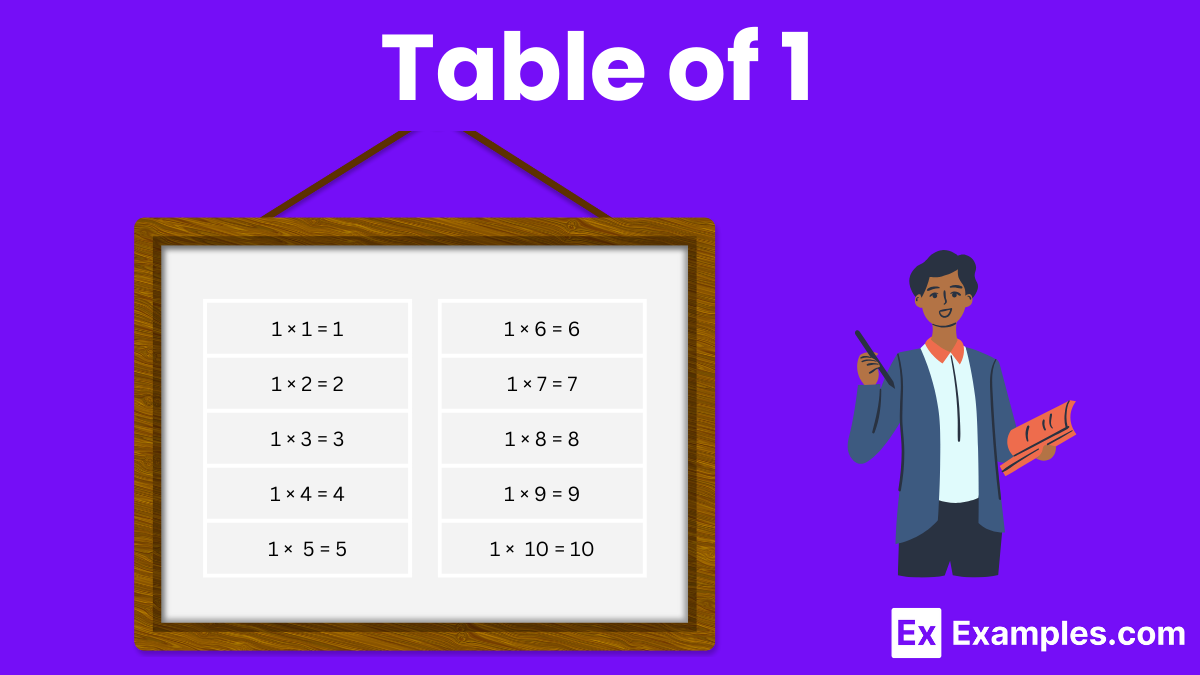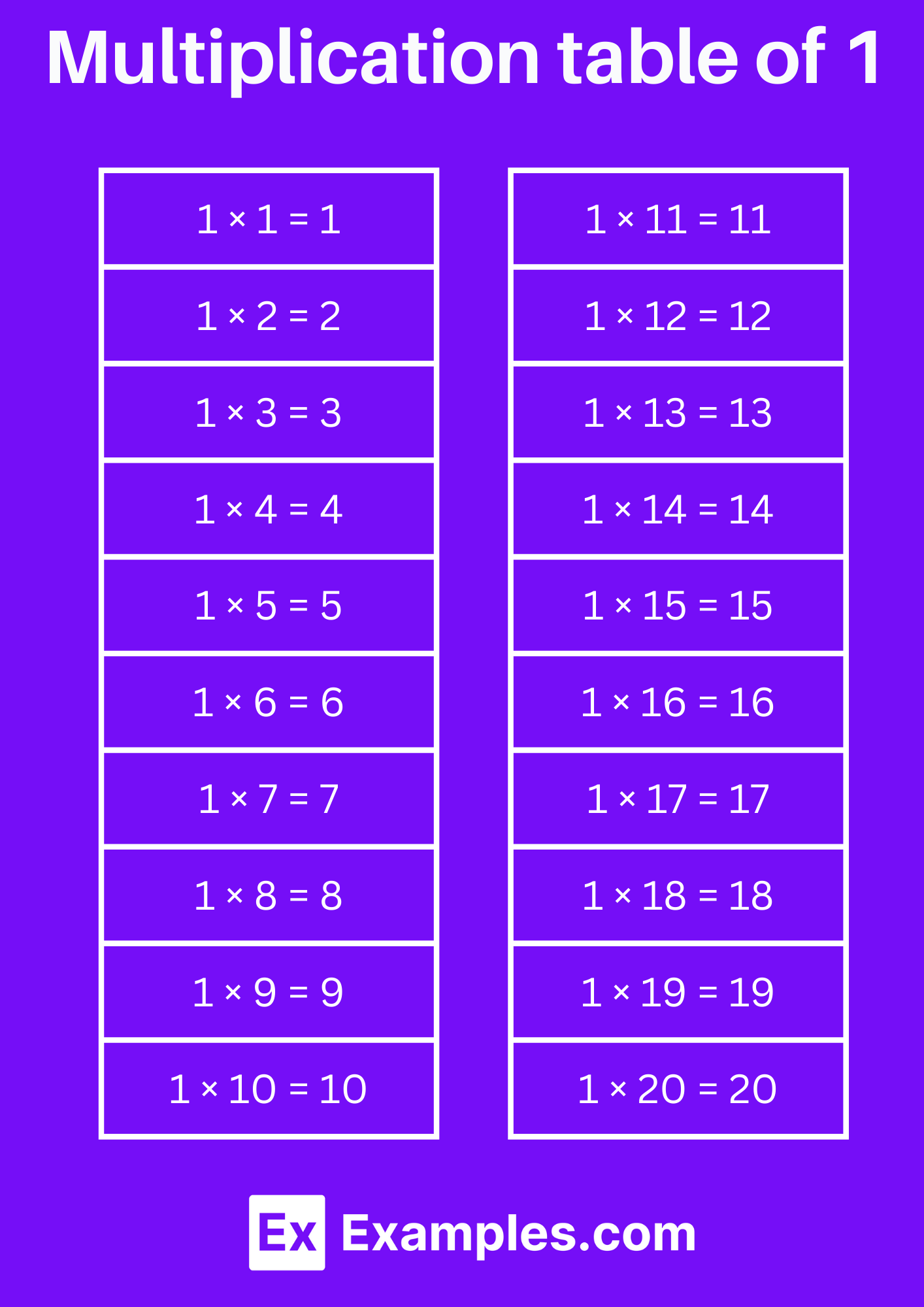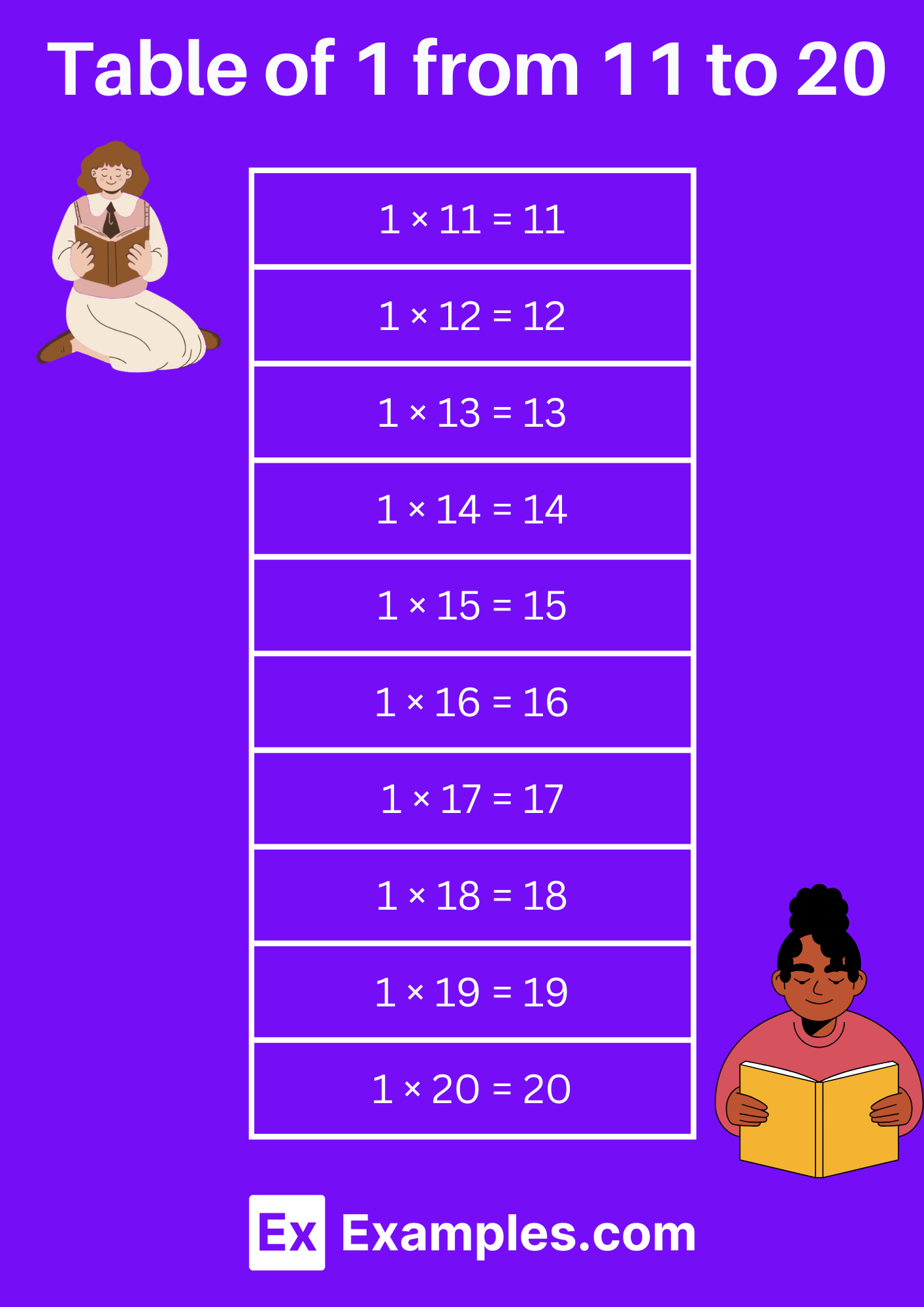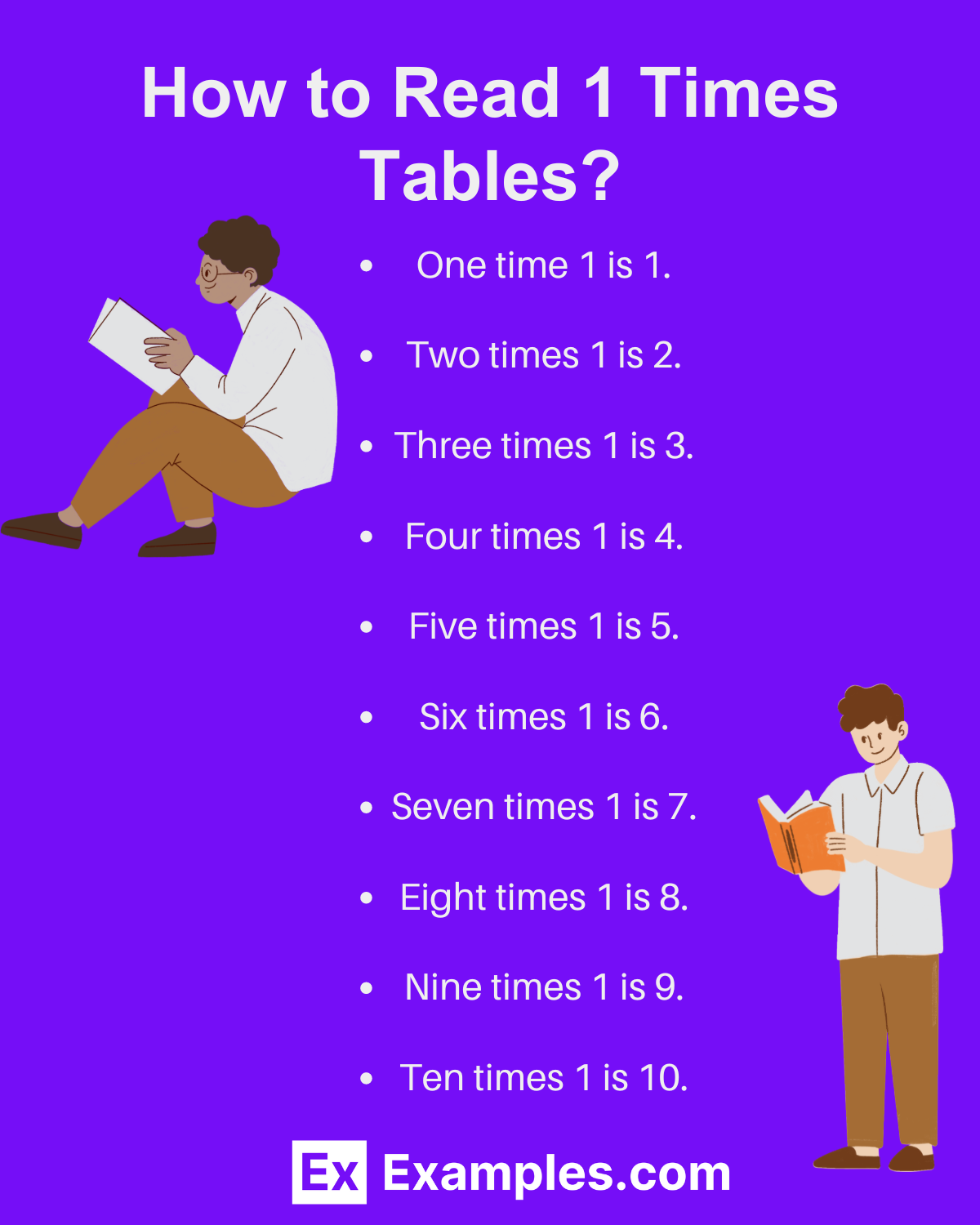What is the product of 1 and 7?
7
8
9
6


In the multiplication table for 1 times 1, each product results in 1. This table is fundamental as it demonstrates that any number multiplied by 1 equals the same number. It serves as the basis for understanding the concept of multiplication and is often the first table learned in arithmetic education. Mastering this table is crucial for building a strong foundation in mathematics and lays the groundwork for learning more complex multiplication concepts.
The multiplication table of 1 is straightforward, as any number multiplied by 1 equals the same number. In this table, each product is simply the number itself. For example, 1 times 1 equals 1, 2 times 1 equals 2, 3 times 1 equals 3, and so on. This pattern continues indefinitely, with each number multiplied by 1 resulting in the same number. Understanding the multiplication table of 1 is fundamental in arithmetic education, as it establishes the basic concept of multiplication and serves as the foundation for learning more complex multiplication tables.
Mastering the multiplication table of 1 is essential for developing strong mental math skills and building a solid mathematical foundation. It is often one of the first tables learned by students, laying the groundwork for understanding multiplication as repeated addition. Additionally, knowing this table enables quick and efficient calculation of single-digit multiplication facts, which is useful in various everyday situations and mathematical problem-solving.

Download Multiplication of 1 Pdf
| Multiplication (1-10) | Multiplication (11-20) |
|---|---|
| 1 × 1 = 1 | 1 × 11 = 11 |
| 1 × 2 = 2 | 1 × 12 = 12 |
| 1 × 3 = 3 | 1 × 13 = 13 |
| 1 × 4 = 4 | 1 × 14 = 14 |
| 1 × 5 = 5 | 1 × 15 = 15 |
| 1 × 6 = 6 | 1 × 16 = 16 |
| 1 × 7 = 7 | 1 × 17 = 17 |
| 1 × 8 = 8 | 1 × 18 = 18 |
| 1 × 9 = 9 | 1 × 19 = 19 |
| 1 × 10 = 10 | 1 × 20 = 20 |
The pattern continues indefinitely, with each number multiplied by 1 resulting in the same number. Mastery of the 1 times table is fundamental in arithmetic education, serving as the foundation for understanding the concept of multiplication and its properties.
| Multiplication | Result |
|---|---|
| 1 × 1 | 1 |
| 1 × 2 | 2 |
| 1 × 3 | 3 |
| 1 × 4 | 4 |
| 1 × 5 | 5 |
| 1 × 6 | 6 |
| 1 × 7 | 7 |
| 1 × 8 | 8 |
| 1 × 9 | 9 |
| 1 × 10 | 10 |
| 1 × 11 | 11 |
| 1 × 12 | 12 |
| 1 × 13 | 13 |
| 1 × 14 | 14 |
| 1 × 15 | 15 |
| 1 × 16 | 16 |
| 1 × 17 | 17 |
| 1 × 18 | 18 |
| 1 × 19 | 19 |
| 1 × 20 | 20 |

Download Tables of1 from 11 to 20 Pdf
| Multiplication | Result |
|---|---|
| 1 × 11 | 11 |
| 1 × 12 | 12 |
| 1 × 13 | 13 |
| 1 × 14 | 14 |
| 1 × 15 | 15 |
| 1 × 16 | 16 |
| 1 × 17 | 17 |
| 1 × 18 | 18 |
| 1 × 19 | 19 |
| 1 × 20 | 20 |

Download Simplest way to memories the table format
| Number | Addition | Result |
|---|---|---|
| 1 | 1 | 1 |
| 2 | 1 + 1 | 2 |
| 3 | 1 + 1 + 1 | 3 |
| 4 | 1 + 1 + 1 + 1 | 4 |
| 5 | 1 + 1 + 1 + 1 + 1 | 5 |
| 6 | 1 + 1 + 1 + 1 + 1 + 1 | 6 |
| 7 | 1 + 1 + 1 + 1 + 1 + 1 + 1 | 7 |
| 8 | 1 + 1 + 1 + 1 + 1 + 1 + 1 + 1 | 8 |
| 9 | 1 + 1 + 1 + 1 + 1 + 1 + 1 + 1 + 1 | 9 |
| 10 | 1 + 1 + 1 + 1 + 1 + 1 + 1 + 1 + 1 + 1 | 10 |
Each row demonstrates the incremental addition of 1, representing numbers from 1 to 10. This method simplifies understanding basic arithmetic concepts.

Download How to read 1 times Tables Pdf
Multiplying each number by itself results in the same number. This simple pattern continues up to ten, aiding in understanding basic multiplication concepts efficiently.
| 1 x 1 = 1 | 2 x 1 = 2 | 3 x 1 = 3 | 4 x 1 = 4 | 5 x 1 = 5 |
| 6 x 1 = 6 | 7 x 1 = 7 | 8 x 1 = 8 | 9 x 1 = 9 | 10 x 1 = 10 |
| 11 x 1 = 11 | 12 x 1 = 12 | 13 x 1 = 13 | 14 x 1 = 14 | 15 x 1 = 15 |
| 16 x 1 = 16 | 17 x 1 = 17 | 18 x 1 = 18 | 19 x 1 = 19 | 20 x 1 = 20 |
| 21 x 1 = 21 | 22 x 1 = 22 | 23 x 1 = 23 | 24 x 1 = 24 | 25 x 1 = 25 |
| 26 x 1 = 26 | 27 x 1 = 27 | 28 x 1 = 28 | 29 x 1 = 29 | 30 x 1 = 30 |
| 31 x 1 = 31 | 32 x 1 = 32 | 33 x 1 = 33 | 34 x 1 = 34 | 35 x 1 = 35 |
| 36 x 1 = 36 | 37 x 1 = 37 | 38 x 1 = 38 | 39 x 1 = 39 | 40 x 1 = 40 |
| 41 x 1 = 41 | 42 x 1 = 42 | 43 x 1 = 43 | 44 x 1 = 44 | 45 x 1 = 45 |
| 46 x 1 = 46 | 47 x 1 = 47 | 48 x 1 = 48 | 49 x 1 = 49 | 50 x 1 = 50 |
| 51 x 1 = 51 | 52 x 1 = 52 | 53 x 1 = 53 | 54 x 1 = 54 | 55 x 1 = 55 |
| 56 x 1 = 56 | 57 x 1 = 57 | 58 x 1 = 58 | 59 x 1 = 59 | 60 x 1 = 60 |
| 61 x 1 = 61 | 62 x 1 = 62 | 63 x 1 = 63 | 64 x 1 = 64 | 65 x 1 = 65 |
| 66 x 1 = 66 | 67 x 1 = 67 | 68 x 1 = 68 | 69 x 1 = 69 | 70 x 1 = 70 |
| 71 x 1 = 71 | 72 x 1 = 72 | 73 x 1 = 73 | 74 x 1 = 74 | 75 x 1 = 75 |
| 76 x 1 = 76 | 77 x 1 = 77 | 78 x 1 = 78 | 79 x 1 = 79 | 80 x 1 = 80 |
| 81 x 1 = 81 | 82 x 1 = 82 | 83 x 1 = 83 | 84 x 1 = 84 | 85 x 1 = 85 |
| 86 x 1 = 86 | 87 x 1 = 87 | 88 x 1 = 88 | 89 x 1 = 89 | 90 x 1 = 90 |
| 91 x 1 = 91 | 92 x 1 = 92 | 93 x 1 = 93 | 94 x 1 = 94 | 95 x 1 = 95 |
| 96 x 1 = 96 | 97 x 1 = 97 | 98 x 1 = 98 | 99 x 1 = 99 | 100 x 1 = 100 |
| 101 x 1 = 101 | 102 x 1 = 102 | 103 x 1 = 103 | 104 x 1 = 104 | 105 x 1 = 105 |
| 106 x 1 = 106 | 107 x 1 = 107 | 108 x 1 = 108 | 109 x 1 = 109 | 110 x 1 = 110 |
| 111 x 1 = 111 | 112 x 1 = 112 | 113 x 1 = 113 | 114 x 1 = 114 | 115 x 1 = 115 |
| 116 x 1 = 116 | 117 x 1 = 117 | 118 x 1 = 118 | 119 x 1 = 119 | 120 x 1 = 120 |
| 121 x 1 = 121 | 122 x 1 = 122 | 123 x 1 = 123 | 124 x 1 = 124 | 125 x 1 = 125 |
| 126 x 1 = 126 | 127 x 1 = 127 | 128 x 1 = 128 | 129 x 1 = 129 | 130 x 1 = 130 |
| 131 x 1 = 131 | 132 x 1 = 132 | 133 x 1 = 133 | 134 x 1 = 134 | 135 x 1 = 135 |
| 136 x 1 = 136 | 137 x 1 = 137 | 138 x 1 = 138 | 139 x 1 = 139 | 140 x 1 = 140 |
| 141 x 1 = 141 | 142 x 1 = 142 | 143 x 1 = 143 | 144 x 1 = 144 | 145 x 1 = 145 |
| 146 x 1 = 146 | 147 x 1 = 147 | 148 x 1 = 148 | 149 x 1 = 149 | 150 x 1 = 150 |
| 151 x 1 = 151 | 152 x 1 = 152 | 153 x 1 = 153 | 154 x 1 = 154 | 155 x 1 = 155 |
| 156 x 1 = 156 | 157 x 1 = 157 | 158 x 1 = 158 | 159 x 1 = 159 | 160 x 1 = 160 |
| 161 x 1 = 161 | 162 x 1 = 162 | 163 x 1 = 163 | 164 x 1 = 164 | 165 x 1 = 165 |
| 166 x 1 = 166 | 167 x 1 = 167 | 168 x 1 = 168 | 169 x 1 = 169 | 170 x 1 = 170 |
| 171 x 1 = 171 | 172 x 1 = 172 | 173 x 1 = 173 | 174 x 1 = 174 | 175 x 1 = 175 |
| 176 x 1 = 176 | 177 x 1 = 177 | 178 x 1 = 178 | 179 x 1 = 179 | 180 x 1 = 180 |
| 181 x 1 = 181 | 182 x 1 = 182 | 183 x 1 = 183 | 184 x 1 = 184 | 185 x 1 = 185 |
| 186 x 1 = 186 | 187 x 1 = 187 | 188 x 1 = 188 | 189 x 1 = 189 | 190 x 1 = 190 |
| 191 x 1 = 191 | 192 x 1 = 192 | 193 x 1 = 193 | 194 x 1 = 194 | 195 x 1 = 195 |
| 196 x 1 = 196 | 197 x 1 = 197 | 198 x 1 = 198 | 199 x 1 = 199 | 200 x 1 = 200 |
| 201 x 1 = 201 | 202 x 1 = 202 | 203 x 1 = 203 | 204 x 1 = 204 | 205 x 1 = 205 |
| 206 x 1 = 206 | 207 x 1 = 207 | 208 x 1 = 208 | 209 x 1 = 209 | 210 x 1 = 210 |
| 211 x 1 = 211 | 212 x 1 = 212 | 213 x 1 = 213 | 214 x 1 = 214 | 215 x 1 = 215 |
| 216 x 1 = 216 | 217 x 1 = 217 | 218 x 1 = 218 | 219 x 1 = 219 | 220 x 1 = 220 |
| 221 x 1 = 221 | 222 x 1 = 222 | 223 x 1 = 223 | 224 x 1 = 224 | 225 x 1 = 225 |
| 226 x 1 = 226 | 227 x 1 = 227 | 228 x 1 = 228 | 229 x 1 = 229 | 230 x 1 = 230 |
| 231 x 1 = 231 | 232 x 1 = 232 | 233 x 1 = 233 | 234 x 1 = 234 | 235 x 1 = 235 |
| 236 x 1 = 236 | 237 x 1 = 237 | 238 x 1 = 238 | 239 x 1 = 239 | 240 x 1 = 240 |
| 241 x 1 = 241 | 242 x 1 = 242 | 243 x 1 = 243 | 244 x 1 = 244 | 245 x 1 = 245 |
| 246 x 1 = 246 | 247 x 1 = 247 | 248 x 1 = 248 | 249 x 1 = 249 | 250 x 1 = 250 |
| 251 x 1 = 251 | 252 x 1 = 252 | 253 x 1 = 253 | 254 x 1 = 254 | 255 x 1 = 255 |
| 256 x 1 = 256 | 257 x 1 = 257 | 258 x 1 = 258 | 259 x 1 = 259 | 260 x 1 = 260 |
| 261 x 1 = 261 | 262 x 1 = 262 | 263 x 1 = 263 | 264 x 1 = 264 | 265 x 1 = 265 |
| 266 x 1 = 266 | 267 x 1 = 267 | 268 x 1 = 268 | 269 x 1 = 269 | 270 x 1 = 270 |
| 271 x 1 = 271 | 272 x 1 = 272 | 273 x 1 = 273 | 274 x 1 = 274 | 275 x 1 = 275 |
| 276 x 1 = 276 | 277 x 1 = 277 | 278 x 1 = 278 | 279 x 1 = 279 | 280 x 1 = 280 |
| 281 x 1 = 281 | 282 x 1 = 282 | 283 x 1 = 283 | 284 x 1 = 284 | 285 x 1 = 285 |
| 286 x 1 = 286 | 287 x 1 = 287 | 288 x 1 = 288 | 289 x 1 = 289 | 290 x 1 = 290 |
| 291 x 1 = 291 | 292 x 1 = 292 | 293 x 1 = 293 | 294 x 1 = 294 | 295 x 1 = 295 |
| 296 x 1 = 296 | 297 x 1 = 297 | 298 x 1 = 298 | 299 x 1 = 299 | 300 x 1 = 300 |
Problem: Multiply 1 by 8.
Solution: 1 x 8 = 8
The result of multiplying any number by 1 is the number itself. Therefore, 1 multiplied by 8 equals 8.
Problem: Multiply 1 by 0.
Solution: 1 x 0 = 0
Even though the identity property states that any number multiplied by 1 gives the number itself, multiplying by zero is an exception. Any number multiplied by zero equals zero, demonstrating the zero property of multiplication.
Problem: Multiply 1 by 123.
Solution: 1 x 123 = 123
Multiplying 1 by 123 results in 123, reinforcing the identity property where the number itself remains unchanged when multiplied by 1.
Problem: Multiply 1 by 3.57.
Solution: 1 x 3.57 = 3.57
When 1 is multiplied by a decimal, the result is the same decimal. Thus, 1 times 3.57 is 3.57. This example confirms that the identity property of multiplication applies to both whole numbers and decimals.
Problem: Multiply 1 by -24.
Solution: 1 x -24 = -24
Multiplying 1 by a negative number does not change the value of the negative number, maintaining the identity property. In this case, 1 multiplied by -24 yields -24.
Text prompt
Add Tone
10 Examples of Public speaking
20 Examples of Gas lighting
What is the product of 1 and 7?
7
8
9
6
What is the result of 1 multiplied by 12?
10
11
12
13
If 1 is multiplied by 8, what is the product?
6
8
7
9
What is 1 times 15?
13
14
15
16
What is the result when 1 is multiplied by 25?
24
25
26
27
What do you get when you multiply 1 by 30?
29
30
31
32
What is the product of 1 and 20?
18
19
20
21
When 1 is multiplied by 40, what is the result?
38
39
40
41
What is 1 times 50?
49
50
51
52
If you multiply 1 by 100, what is the outcome?
99
100
101
102
Before you leave, take our quick quiz to enhance your learning!

